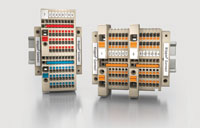
Posted to News on 23rd Nov 2016, 00:00
Connect with success
Design engineers often see terminals as a necessary evil. They need them but, unlike many of the complex components that make up modern automation systems, they don’t do anything particularly interesting. So why spend a lot of time thinking about them? The answer, says Peter Croucher, product manager at Weidmüller UK, is that choosing the right terminals leads to financial and time savings out of all proportion to their cost.

In principle, terminals are very simple devices. Nevertheless, they play an essential role in almost every automation system and it’s not exactly news that, when it comes to terminals, product quality is always a key requirement. A faulty terminal can stop a plant from functioning just as surely as a faulty PLC or drive. And, since in many applications there may be hundreds or even thousands of terminals and only a few drives and PLCs, it’s perfectly possible that a faulty terminal will be harder to find.
So it pays to buy the best from a terminal manufacturer that has an unsullied reputation for producing dependable top quality products. But today, where automation technology is advancing ever more rapidly and the pressures on project costs and timescales have never been greater, is product quality alone a sufficient criterion for terminal selection?
The answer has to be no. Good quality terminals, used within their ratings and operating parameters, will always get the job done, but the right terminals for a particular application will offer much more – they’ll reduce the time it takes to design, build and commission a project, they’ll save space and, over the whole service life of the equipment they’re used in, they’ll make fault-finding and maintenance easier and faster. In short, the right terminals will save time and money at every project stage. But how can something as simple as a terminal have such a large influence on project success? Let’s find out.
As we’ve already noted, terminals do a deceptively simple job, but they’re available in a huge range of types, and possibly the most basic difference between the various types is the connection technology used. Currently the most popular option by far is the screw clamp terminal. These are readily available and they offer a wide range of solutions and are capable of providing excellent results. Wiring these terminals, however, is a relatively time-consuming process, simply because of the time it takes to tighten the clamping screw. Another factor to be considered is that the screw must be correctly tightened; if it isn’t tightened sufficiently, there is a risk of a poor connection, but if it’s over-tightened the cable may be damaged.
Spring-clamp terminals
An alternative option that has become very popular in recent years is spring-clamp terminals. These are quicker to wire than screw-clamp terminals as it’s only necessary to open the spring with a screwdriver or similar tool, insert the wire, and then release the spring. There’s no tightening to worry about – correct clamping tension for the wire is automatically achieved. A further benefit is that, because of the spring action, the connections are unaffected by vibration.
More recently still, a third type of terminal has started to make big inroads into the market. This is the push-in terminal. Once again, this uses a sprung clamp, but the big difference is that it is not necessary to open the clamp before inserting the wire. All that’s necessary is to push the wire into the terminal, and the job is done! No tools are needed, and the security of the connection is guaranteed. This type of terminal allows wiring time to be significantly reduced, which translates into substantial cost savings, especially in larger projects.
It’s not just the connection technologies that have evolved in recent years. Designs of the latest products have been refined so that they occupy less space on the terminal rail, and offer much higher wiring density than their predecessors. This is important as space in control panels and junction boxes is expensive, and there is a constant demand to fit automation systems – despite their growing capabilities – into smaller and smaller spaces.
Of course, high density wiring potentially makes it more difficult to see which wire goes where. This problem is addressed in the best terminals, however, by careful design that ensures functional transparency, and by extensive provision for clear, easily visible labelling. Coloured terminals are also available to indicate earth connections and other special functions.
These new-generation terminals are not simply compact, easy to use and dependable, they’re also very versatile. As standard, for example, many include a test point, which makes it much easier to carrying out commissioning and fault finding on the equipment in which they are used. And their versatility can be further extended with accessories like cross connectors that can be fitted easily and quickly.
These modern universal terminals are an excellent choice for almost any application but sometimes there is an even better choice – application specific terminals. These have been developed to provide a fast, dependable and convenient solution in a range of frequently encountered applications.
Application-specific terminals, for example, include types for use with current and voltage instrument transformers, which guard against the incorrect or missing connections that could destroy the transformer. Another example is terminals for signal wiring, which allow a very large number of three- or four-wire sensors and actuators to be terminated in a very small space. These terminals are colour coded to guard against incorrect connections, and incorporate test points for all of the different potential levels used.
Application-specific voltage distribution terminals are also available, which provide a convenient and compact solution to the frequently encountered problem of providing supplies to a large number of field devices.
These are complemented by load-monitoring voltage distribution terminals that not only provide convenient supply connections for field devices, but also monitor the current drawn by each device. If the current exceeds a preset value, the supply to the device is automatically turned off, protecting both the device and the power source. This functionality is not new, of course, but has previously required the use of a terminal and a separate protection device for each field device. Now all of the functionality is provided in a single slim rail-mounting terminal.
Designing terminal rails
It’s clear that the latest terminals offer much more than can be expected from older types, but terminals can still be something of a headache for automation system design engineers. Designing terminal rails, ordering all of the right parts needed to assemble them, taking care of marking and identification requirements – all of these are time-consuming, tedious tasks that, largely because of their tedium, are simply an invitation for errors to occur.
Fortunately, terminal suppliers with a close connection to their market and a good understanding of their users’ needs have developed an effective solution to this problem by providing extensive software support for their products. This configurator software, which the best suppliers offer free of charge, provides support for engineers at every step of the design process, from choosing the best type of terminal for the job in hand to configuring the layout of the terminal rails and ordering the markers.
It is worth noting that good terminal configurator software is preloaded with data about every aspect of the terminals – not just the overall dimensions or the current rating. This enables the software to monitor the engineer’s design and to warn of possible errors before so much as a single component has been ordered. It will also generate 3D views of the terminal rail, so that the engineer can see exactly how the final arrangement will appear.
Once the engineer is satisfied with their design, the configurator software will generate a parts list that can be sent direct to the terminal supplier. This means that there’s no chance of the wrong components being ordered or of essential items being forgotten.
Of course, many companies involved with the design of automation systems already use computer-aided engineering (CAE) software. To cater for these, terminal suppliers with a good understanding of their customers’ needs have designed their configurators so that terminal data and terminal bar designs can be readily exported to leading CAE packages.
I hope this article has shown that terminals are much more interesting than they might at first appear and has also justified the claim that the right terminals will save time and money at every project stage.
At the design stage, engineers save time by quickly generating terminal bar designs, safe in the knowledge that the designs are automatically checked to ensure that they’re free from errors. At the assembly stage, money is saved because modern terminals take up much less space than their older counterparts and because application-specific terminals need much less assembly and configuration than standard terminals arranged to provide the same functionality.
Moving on to wiring, the latest push-in terminals dramatically reduce the time taken and, during the test and commissioning phases, features like conveniently accessible test points and load monitoring terminals that protect against equipment damage once again save time and money.
These same features, allied with inherent reliability of the best modern terminals, will continue to deliver savings throughout the life of the equipment in which they’re used. In summary, if you’re involved with the design and manufacture of automation systems, choosing modern terminals from an innovative manufacturer like Weidmüller is a sure way to connect with success.
Klippon House, Centurion Court Office Park
Meridian East, Meridian Business Park
LE19 1TP
UNITED KINGDOM
+44(0)116 282 3470






